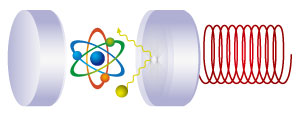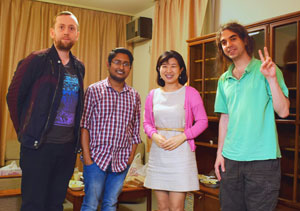Nov. 10, 2017 Research Highlight Physics / Astronomy
Measuring the unmeasurable
Virtual excitations, which are typically hidden, can be revealed by the pressure they exert on a movable mirror
 Figure 1: Combining an optical cavity (two mirrors) and an optomechanical system (spring on the right) could enable virtual photons (yellow particle) to be detected. © 2017 RIKEN Center for Emergent Matter Science
Figure 1: Combining an optical cavity (two mirrors) and an optomechanical system (spring on the right) could enable virtual photons (yellow particle) to be detected. © 2017 RIKEN Center for Emergent Matter Science
A new scheme for observing the influence of light particles that fleetingly form out of nothing before vanishing has been proposed by an all-RIKEN team1.
Quantum theory predicts that particles can briefly spring into existence from an otherwise empty space before disappearing again. In the case of light, these quantum fluctuations are dubbed virtual photons.
Now, calculations performed by Mauro Cirio and three co-workers from the RIKEN Center for Emergent Matter Science predict an optical cavity could be used to amplify the physical force exerted by such virtual photons to detectable levels.
Optical cavities trap light between mirrors. They can host a wide range of fascinating physics because of their ability to enhance the strength with which light interacts with any matter placed within them. If this interaction can be engineered to be sufficiently strong, quantum fluctuations will become relevant.
“In the ultrastrong-coupling regime, light and matter are intertwined and become mixed concepts,” explains Cirio. In this strong-interaction case, the lowest energy state of a system consisting of a single atom in a cavity contains excitations in the atom ‘intertwined’ with virtual photons, which can exist only within the cavity. And just like conventional photons, these virtual photons will exert a force on the cavity mirrors as they bounce off them.
“We were interested in finding a way to measure the presence of the virtual photons trapped in the system, without destroying them,” says Cirio. “This led us to the new idea of quantifying how much force the virtual photons exert on a mirror as virtual radiation pressure.”
 Three of the paper’s authors: Neill Lambert (far left), Kamanasish Debnath (center left), Mauro Cirio (far right). Ai Sato (center right) is assistant of the authors' laboratory. © 2017 RIKEN
Three of the paper’s authors: Neill Lambert (far left), Kamanasish Debnath (center left), Mauro Cirio (far right). Ai Sato (center right) is assistant of the authors' laboratory. © 2017 RIKEN
But the size of this force is miniscule. To measure it, Cirio and the team proposed using a set-up that combines an atom in an optical cavity and an optomechanical system (Fig. 1). Such a system effectively couples light and mechanical vibrations. The researchers numerically analyzed this hybrid set-up and showed that their powerful protocol can amplify the tiny force acting on the mirror by several orders of magnitude. This amplification is large enough to make the force, in principle, detectable with current state-of-the-art technology. For example, the scientists believe that the idea could be achieved using a microwave cavity that is capacitively coupled to a micromechanical membrane whose motion varies the frequency of the cavity.
The proposed measurement system could have wider application. “We are very much interested in extending the amplification process to other contexts that require the detection of tiny forces,” says Cirio.
Related contents
- Single photon excites two atoms at once
- Particles find their mass
- Frustration produces a quantum playground
References
- 1. Cirio, M., Debnath, K., Lambert, N. & Nori, F. Amplified optomechanical transduction of virtual radiation pressure. Physical Review Letters 119, 053601 (2017). doi: 10.1103/PhysRevLett.119.053601
- 2. Measuring the very real pressure of virtual photons, Physics Central Physics Buzz Blog
